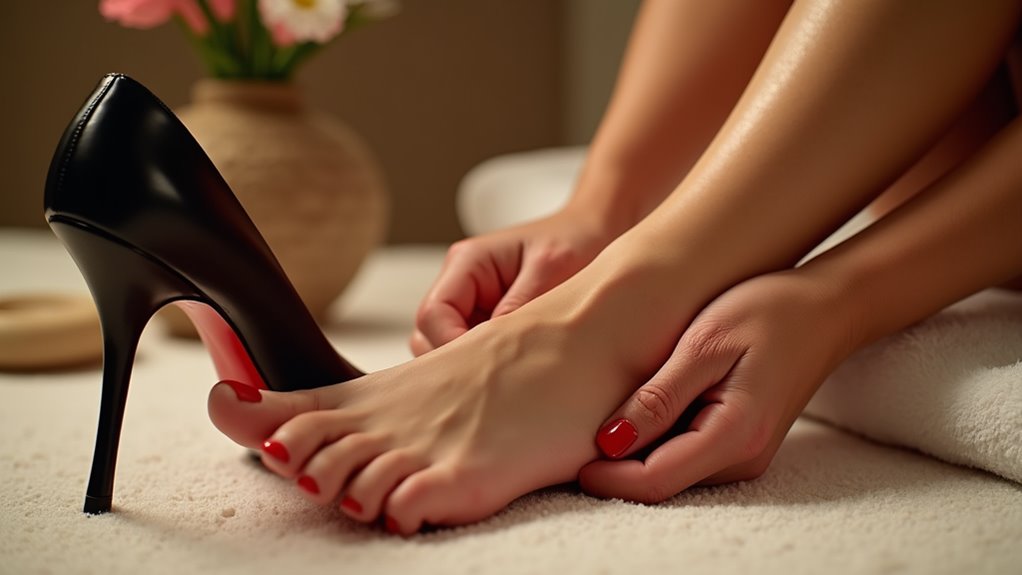There may be products. Products are independently selected by our editors. We may earn an affiliate commission from the links with no charge to you, example: as Amazon Affiliate.
Did you know that women who regularly wear high heels are ten times more likely to develop foot-related issues than those who don’t? If you’re among the millions who sacrifice comfort for style, you’ll want to understand how proper foot massage techniques can prevent long-term damage to your feet. While occasional heel wear might seem harmless, the accumulated stress on your feet can lead to chronic problems affecting your ankles, knees, and even your back. The good news is that you can significantly reduce this impact with targeted massage methods that address specific pressure points and tension areas.
Key Takeaways
- Begin with a 10-minute warm water soak to soften tissues, then apply gentle circular motions around ankles and heels.
- Use thumbs to perform deep pressure massage along the arch and plantar fascia from heel to toes.
- Roll a tennis ball under the foot while seated, focusing on painful spots for 2-3 minutes each.
- Target the base of the heel with firm circular motions, followed by gentle stretching of the Achilles tendon.
- Finish with toe stretches and gentle twisting movements to increase flexibility and reduce cramping.
Why Feet Need Special Care
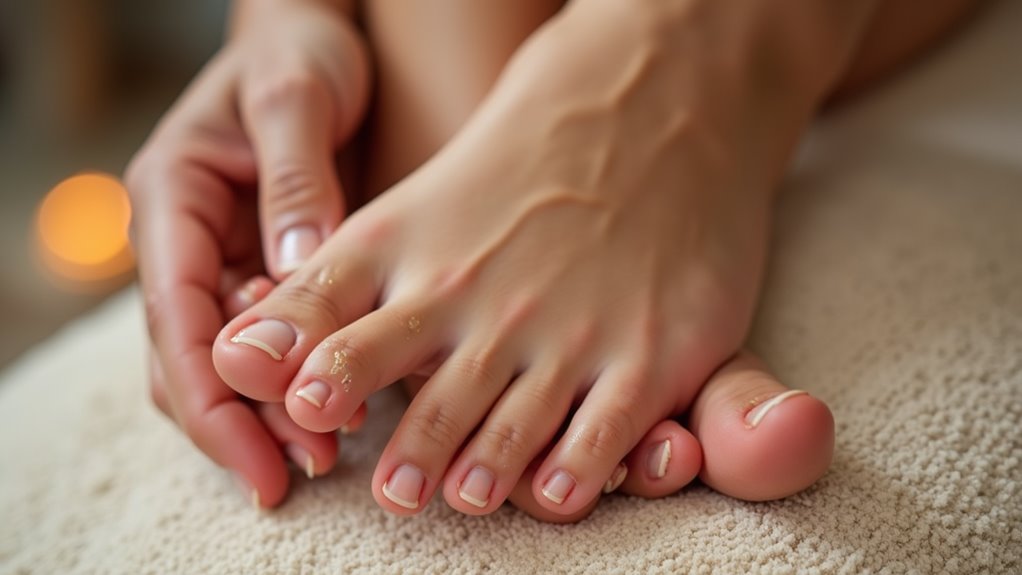
While many people overlook foot care in their daily routine, your feet are complex structures that deserve special attention. With 26 bones, 33 joints, and over 100 muscles, tendons, and ligaments, your feet are engineering marvels that support your entire body.
Each foot contains roughly 8,000 nerve endings, making them incredibly sensitive to touch and pressure.
You’re putting significant strain on your feet daily, as they absorb the impact of 4,000-6,000 steps. Neglecting their care can lead to various problems, from minor discomfort to serious mobility issues.
When you ignore foot health, you’re risking conditions like blisters, corns, and fungal infections. Proper foot care isn’t just about comfort – it’s essential for maintaining your overall health and preventing complications that could affect your quality of life.
Finding the right heel bottom support can significantly reduce foot strain and discomfort when wearing high heels.
Preparing for Your Foot Treatment
Before beginning a foot massage, creating the right environment and gathering necessary supplies will enhance the therapeutic experience. Start by soaking your feet in warm water for 5-10 minutes, adding essential oils for aromatherapy benefits. While your feet soak, set up a comfortable space with warm lighting and soothing music. Consider wearing comfort-focused heel designs throughout the day to minimize foot strain before your massage session.
| Preparation Step | What You’ll Need |
|---|---|
| Foot Soak | Warm water, essential oils |
| Surface Setup | Clean towels, waterproof cover |
| Massage Tools | Massage oil, tennis ball |
| Ambiance | Candles, relaxing music |
| Products | Foot cream, moisturizer |
After soaking, pat your feet dry and position yourself comfortably. Warm the massage oil between your palms before applying it. Remember to start with gentle pressure at the heel, gradually working toward the toes using circular motions with your thumbs.
Essential Massage Movements
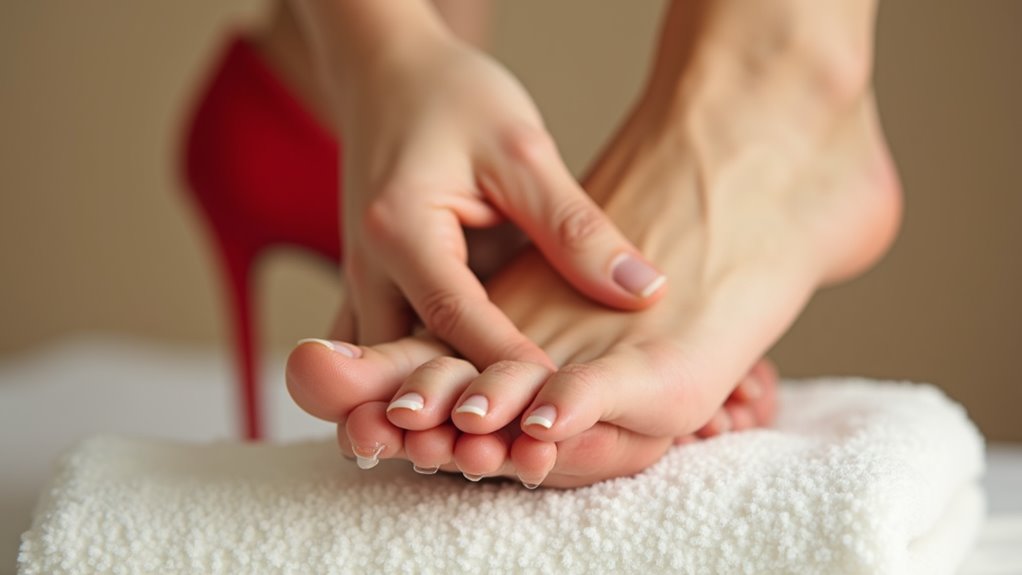
Four essential massage movements form the foundation of an effective foot treatment: warming techniques, pressure point work, deep tissue manipulation, and advanced relief methods.
Start with gentle warmup twists and toe circles to increase circulation.
Then, apply firm pressure to the solar plexus point while encouraging deep breathing.
For deep tissue work, use your thumbs to massage the plantar fascia in circular motions, focusing on the heel area. You’ll want to incorporate knuckle kneading and firm thumb strokes along each toe.
For advanced relief, incorporate warm stone techniques. Scrape from the solar plexus to the heel, and roll the stone between the metatarsals.
Remember to maintain smooth movements, use proper lubricant, and adjust pressure based on your client’s comfort level.
Heel-Focused Relief Techniques
Effective heel massage requires five targeted movements to alleviate discomfort and promote healing.
Start by applying deep pressure at the heel’s base where your plantar fascia connects to the bone. Use your thumbs to create circular motions while gradually increasing pressure.
Next, cup your heel and rock it gently side to side while maintaining consistent thumb pressure.
For deeper relief, use your knuckles or fist to knead the bottom of your foot, focusing on any tender spots.
Finally, perform a wringing motion across your entire foot, followed by steady strokes down your Achilles tendon.
Don’t forget to target pressure points along your instep, and finish by spreading your foot outward to restore its natural width.
These techniques will help reduce inflammation and improve flexibility in your heel area.
Consider pairing these massage techniques with supportive heel design shoes to maximize long-term comfort and pain relief.
Strengthening Exercises for Feet
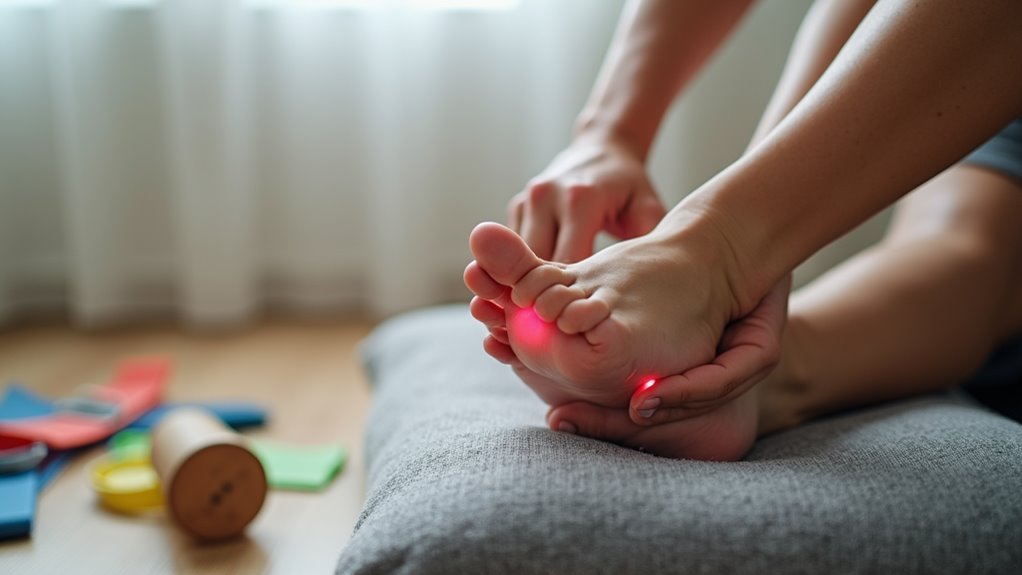
Building strong, resilient feet requires consistent exercise to maintain optimal function and prevent common problems.
You’ll want to focus on simple yet effective movements like toe raises and scrunches to strengthen your foot muscles. Start with basic exercises such as picking up marbles with your toes or grasping a towel, then gradually increase the difficulty as you progress.
For the best results, you’ll need to perform these exercises regularly while wearing proper footwear.
Combine both flexibility and strength training by incorporating ankle pumps and calf raises into your routine. These movements will improve your balance, enhance posture, and reduce your risk of injuries.
If you’re unsure about proper form, don’t hesitate to consult a podiatrist for personalized guidance.
Plantar Fascia Care
You’ll want to release tight plantar fascia tissue daily to prevent foot pain and stiffness.
Rolling a tennis ball or golf ball under your foot provides an effective self-massage that breaks up adhesions and increases blood flow to the area.
This simple technique helps reduce inflammation while loosening the connective tissue that runs along the bottom of your foot.
Release Tight Fascia Daily
Taking care of your plantar fascia becomes essential when you’re dealing with foot discomfort or trying to prevent future problems.
Start by reducing high-impact activities and incorporating daily stretching exercises to release tension. Roll a tennis ball under your foot and perform heel drops from a step to target tight areas.
You’ll need to wear shoes with proper arch support and shock absorption to protect your feet throughout the day.
Don’t forget to stretch your Achilles tendon and calves, as they directly affect foot tension. If you’re experiencing persistent pain, try using night splints and applying ice after activity.
For added relief, practice circular massage on your heel and pick up marbles with your toes to strengthen foot muscles.
Massage Ball Rolling Benefits
Rolling a massage ball under your feet offers powerful relief for plantar fascia discomfort.
You’ll break up painful adhesions in your foot arches while improving blood circulation, which speeds up healing. Whether you choose a firm Rawlogy ball, tennis ball, or even a frozen water bottle, you’re targeting specific areas that need attention.
As you roll the ball from heel to toe, you’ll loosen tight fascia and strengthen your foot muscles. The deep tissue massage helps reduce inflammation and prevents painful calcium crystal formation.
You can control the pressure to match your comfort level while addressing connected muscle groups. For best results, combine your rolling routine with other treatments like physical therapy and orthotic support.
Remember to roll each foot for 30-45 seconds using smooth, controlled movements.
Preventing Future Discomfort
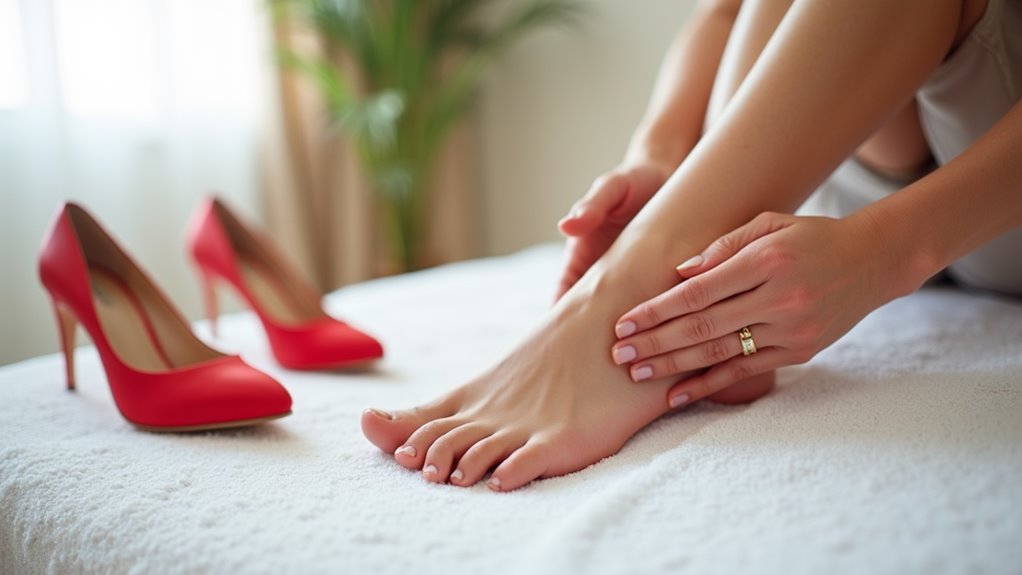
You’ll prevent future foot discomfort by choosing shoes that offer proper arch support and cushioning while avoiding high heels that strain your muscles.
Make stretching a daily habit, focusing on toe raises and ankle rotations to maintain flexibility and strength in your feet.
Consider switching to eco-friendly non-leather heels that provide sustainable style while maintaining comfort.
Smart Shoe Selection Tips
When it comes to preventing foot discomfort, smart shoe selection plays a crucial role in maintaining healthy feet. Choose heels no higher than 2-3 inches to ensure better weight distribution and reduce pressure on your feet’s pressure points. Opt for shoes made from flexible materials like suede or leather, and look for designs with ankle straps for added stability.
Before purchasing, measure your feet and try the shoes on different surfaces. You’ll want to ensure they fit snugly without pinching. Consider heels with wider bases or platforms, as they’ll provide better stability and support.
Don’t forget to break in your new shoes before wearing them to important events. For extra comfort, invest in cushioned insoles or custom orthotics designed specifically for high heels.
Regular Stretching Habits
Regular stretching habits create a strong foundation for preventing foot discomfort, especially if you frequently wear high heels.
You’ll want to incorporate daily stretches like calf raises, towel pulls, and heel cord exercises into your routine to maintain flexibility and reduce pain risk.
Before slipping into your heels, perform pre-wear stretches to prepare your feet and ankles.
Once you’ve finished wearing them, don’t skip your post-heel stretches – they’re crucial for muscle recovery.
Strengthen your feet with toe curls and ankle rotations to build resilience against strain.
Make maintenance massages part of your regimen by rolling a tennis ball under your feet or using thumb pressure to work out tight spots in your arches and heels.
These consistent practices will help protect your feet from future discomfort.
Conclusion
While your feet take the burden of fashion’s demands, they don’t have to suffer silently. You’ll find relief through these targeted massage techniques, transforming aching arches into rejuvenated foundations. By incorporating these healing movements into your daily routine, you’re not just treating pain – you’re strengthening your feet for tomorrow’s challenges. Let comfort and style coexist as you care for your hardworking feet.

